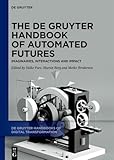The De Gruyter Handbook of Automated Futures : Imaginaries, Interactions and Impact / ed. by Vaike Fors, Martin Berg, Meike Brodersen.
Material type: TextSeries: De Gruyter Handbooks of Digital Transformation ; 2Publisher: Berlin ; Boston : De Gruyter, [2024]Copyright date: 2024Description: 1 online resource (X, 464 p.)Content type:
TextSeries: De Gruyter Handbooks of Digital Transformation ; 2Publisher: Berlin ; Boston : De Gruyter, [2024]Copyright date: 2024Description: 1 online resource (X, 464 p.)Content type: - 9783110792249
- 9783110792348
- 9783110792256
- 303.483
- online - DeGruyter
- Issued also in print.
| Item type | Current library | Call number | URL | Status | Notes | Barcode | |
|---|---|---|---|---|---|---|---|
 eBook
eBook
|
Biblioteca "Angelicum" Pont. Univ. S.Tommaso d'Aquino Nuvola online | online - DeGruyter (Browse shelf(Opens below)) | Online access | Not for loan (Accesso limitato) | Accesso per gli utenti autorizzati / Access for authorized users | (dgr)9783110792256 |
Frontmatter -- Contents -- List of Figures -- List of Tables -- Chapter 1 Navigating Automated Futures: A Framework for Playing and Learning with Imaginaries, Interactions, and Impact -- Chapter 2 Automation and Futures: Doing Social Science Forward -- Part 1: Imaginaries -- Chapter 3 Peter’s Problem. An Analysis of the Imaginaries about Automated Futures Portrayed in QualityLand -- Chapter 4 ‘Where are my robots, Mija?!’ A Situated Review of Technological Change Narratives in Latin America -- Chapter 5 The Possible Futures of Automated Public Space -- Chapter 6 Small Automation: Thinking Through the Texture of Automated Systems -- Chapter 7 The House as a Machine for Living: Dreams of Domestic Automation, 1923–2023 -- Chapter 8 Necrorobotics. The Ethics of Resurrecting the Dead -- Chapter 9 Unveiling Ambiguity: Dilemmas of Automation in Medical Imaging -- Chapter 10 Algorithmic Europe: Narratives of Risks and Benefits of Public–Private Interaction in Public Sector AI -- Part 2: Interactions -- Chapter 11 Algorithmic Agency, Automated Content, and User Engagement on TikTok -- Chapter 12 Garbage In, Garbage Out: Predictive Policing and Structural Biases in Automated Criminal Justice Techniques -- Chapter 13 Sound Automation: Some Provisional Lessons from Electronic Music -- Chapter 14 Collaborative Future-Making: Bridging the Everyday and the Global Political Economy of Automated Health -- Chapter 15 Pursuing the Promises of Personalisation: Fetish and Friction in Futures of Automated News -- Chapter 16 Beyond Human Oversight—Quality Management as a Tool to Control Automated Decision-Making Systems -- Chapter 17 Beware of ‘Bossware’: The Role of Communities for Gig Workers Dealing with Algorithmic Management -- Chapter 18 Silicon Valley’s Frictionless Future: The Design Philosophy of Frictionlessness -- Chapter 19 Automated Afterlives -- Chapter 20 Wuthering Weights—Localisation Trajectories of Machine Learning Models for Local Ends -- Part 3: Impacts -- Chapter 21 Co-making and Prototyping Community Housing Futures -- Chapter 22 Exploring Automated Futures through Game-making -- Chapter 23 Soothing the Socio-Ethical Unease: Trolley Problems in the Age of Automated Decision-Making -- Chapter 24 Arts-Based and Sensory Methods to Imagine More-than-Human Automated Futures -- Chapter 25 Sustainable Automated Futures: Participatory Human Approaches to Urban Mobility -- Chapter 26 People on the Road: From Automated Mobility to Autonomous Human Actors through a People-Centred Approach -- Author Biographies -- Index
restricted access online access with authorization star
http://purl.org/coar/access_right/c_16ec
How does automation affect us, our environment, and our imaginations? What actions should we take in response to automation? Beyond grand narratives and technology-driven visions of the future, what more can automation offer? With these questions in mind, The De Gruyter Handbook of Automated Futures provides a framework for thinking about and implementing automation differently. It consolidates automated futures as an inter- and transdisciplinary research field, embedding the imaginaries, interactions, and impacts of automation technology within their social, historical, societal, cultural, and political contexts. Promoting a critical yet constructive and engaging agenda, the handbook invites readers to collaborate with rather than resist automation agendas. It does so by pushing the agenda for social science, humanities and design beyond merely assessing and evaluating existing technologies. Instead, the handbook demonstrates how the humanities and social sciences are essential to the design and governance of sustainable sociotechnical systems. Methodologically, the handbook is underpinned by a pedagogical approach to staging co-learning and co-creation of automated futures with, rather than simply for, people. In this way, the handbook encourages readers to explore new and alternative modes of research, fostering a deeper engagement with the evolving landscape of automation.
Issued also in print.
Mode of access: Internet via World Wide Web.
In English.
Description based on online resource; title from PDF title page (publisher's Web site, viewed 20. Nov 2024)


